

While I wasn’t present at the moment of design inception, it is my impression that the original intent of a full length stock was to protect a gun’s barrel when pressed into service within a harsh environment… like war, as exemplified by any number of pre-Vietnam era design military firearms. The same notion was carried over to sporting firearms for hunting in extreme conditions.
Today, as most hunters are placed on hand trucks by their outfitters and wheeled out to palatial tree stands, or driven out to baited sites in air conditioned and tinted windowed ATV’s, rough terrain damage to a firearm is probably not in the cards. Even if the threat of firearm damage did remain, few hunters would consider defending an indestructibly finished steel gun barrel with a highly figured chunk of hand checkered walnut. So it is safe to conclude that full length stocks exist today for their aesthetic qualities.
An impressionable youth under the influence of Stoeger’s “Shooter’s Bible”, and prior to my first physics class, Mannlicher Schoenauer’s butter knife bolt handled rifles held a prominent place in my plans for future firearm ownership. Today, much older and just a little bit wiser, I know that the $2,500 – $4,500 an original Mannlicher Schoenauer 6.5 X 54mm can command would deliver an anemic cartridge, a velocity snuffing 18.5″ barrel, a hefty 8 lb+ empty weight, and a split receiver with scope mounting perplexities that rival those of the Russian Mosin Nagant. Fortunately, a number of companies do produce full length stock sporting firearms with an Old World Bavarian bent, utilizing much improved hardware and assembled within modern manufacturing environments.
The case for nostalgia inducing bookends…
 Differing from the original Mannlicher, products from Česká Zbrojovka and Steyr both have distinctive hog’s back stocks with higher combs and angular raised cheek pieces that make them more suitable for both scoped and open sight shooting. The Steyr is a $4,000+ gun, the Česká Zbrojovka’s CZ-USA Model 550 FS can be purchased for under $800, which, in my simplistic view of the world, labels the Steyr as exceedingly overpriced and the CZ an excellent value.
Differing from the original Mannlicher, products from Česká Zbrojovka and Steyr both have distinctive hog’s back stocks with higher combs and angular raised cheek pieces that make them more suitable for both scoped and open sight shooting. The Steyr is a $4,000+ gun, the Česká Zbrojovka’s CZ-USA Model 550 FS can be purchased for under $800, which, in my simplistic view of the world, labels the Steyr as exceedingly overpriced and the CZ an excellent value.
As the satisfied owner of a CZ 550 FS chambered for the 9.3x62mm, a cartridge suitable for hunting anything on the North American continent, it seemed a smaller bore version of the same would be useful for deer, boar and larger sized varmint hunting. The FS is available in .243 Winchester, 6.5x55mm, .270 Winchester, .30-06 Springfield, and .308 Winchester. I decided the .243 Winchester was a bit too light, the 20.5″ barrel length was too short to extract the potential of the .270 Winchester and .30-06 Springfield and the .308 Winchester was too boring to select for such an interesting firearm. The 6.5x55mm Swedish Mauser chamber seemed to be a good fit and I was looking forward to working with the high sectional density .264″ bullet.
Same model, some functional and some aesthetic differences…
 The newer 6.5x55mm version of the CZ 550 (left) is quite different in detail from the 9.3x62mm version of the gun I purchased a couple of years ago. The 9.3x62mm’s action is stamped “550 Medium”, a designation that also applies to CZ 550’s chambered for the 7mm RemingtonMagnum and .300 Winchester Magnum. Both 6.5 and 9.3 actions are of the same strength and .30-06 Springfield length, however, the smaller bore gun does not have an extra under-barrel dovetail mounted recoil lug or cross bolts.
The newer 6.5x55mm version of the CZ 550 (left) is quite different in detail from the 9.3x62mm version of the gun I purchased a couple of years ago. The 9.3x62mm’s action is stamped “550 Medium”, a designation that also applies to CZ 550’s chambered for the 7mm RemingtonMagnum and .300 Winchester Magnum. Both 6.5 and 9.3 actions are of the same strength and .30-06 Springfield length, however, the smaller bore gun does not have an extra under-barrel dovetail mounted recoil lug or cross bolts.
Another difference between the earlier 9.3mm and later 6.5mm 550 FS gun is that the newer 550 FS has a fiber-filled plastic hinged magazine cover attached to the one piece steel trigger guard / floorplate assembly. The newer gun has a steel magazine follower, while the earlier production has a plastic follower. Structurally, I would rate both assemblies the same and the use of filled plastic probably shaves off a few ounces. My preference would be a blending of the two as in a steel magazine cover and steel follower. It is my understanding that customers purchasing new CZ 550 Full Stock models may arrange with the CZ-USA customer service department to exchange the plastic magazine cover assembly for a steel version.

The images to the right illustrate other mostly aesthetic differences. The current CZ 550 configuration is the top gun in each set. As noted earlier, the 6.5x55mm gun does not have twin cross bolts through the side of the stock and it has a filled plastic magazine cover. The 9.3x62mm version retains the cross bolts.
The Bavarian style cheek piece is angular on both, the 6.5mm gun is stepped and cut shorter. It also has approximately 1/4″ less drop at the comb and heal; 3/4″ and 1 3/4″ down from bore centerline respectively, theoretically making the 6.5x55mm a bit better suited to scope use, however, I’ve encountered no problems shooting the 9.3mm gun with a scope in place and both have much less drop from bore centerline than the original MannlicherSchoenauer sporting rifle.
The newer gun has a much darker finish, well-defined and contrasting figure with clean, artfully paneled checkering. The earlier version stock seems more trim, particularly in the grip area and that rifle weighs approximately 6 oz less than the newer gun. Both stocks are cleanly inletted and sealed on the outside and in places not normally visible.
The new gun’s pistol grip inside radius is tighter and the grip cap is quite pronounced. The tighter radius is achieved by moving upper grip aft. In fact, the reach from grip to trigger on the newer gun is 3″ compared to 2 3/4″ for earlier production. The pull is 14 1/4″ for the new gun compared to 13 7/8″ for the early gun. All and all, the newer model is more comfortable and natural to grip and it feels more… under control when shouldered.

 At the rear of the bolt shroud is a pin that acts as a cocked condition indicator. A feature not shared with all CZ rifle models is a three position safety; safe, safe allowing cycling to empty the gun’s magazine and safe and bolt locked in closed position.
At the rear of the bolt shroud is a pin that acts as a cocked condition indicator. A feature not shared with all CZ rifle models is a three position safety; safe, safe allowing cycling to empty the gun’s magazine and safe and bolt locked in closed position.
The CZ 550 is very solid square bridge Mauser derivative with integral 19mm dovetails for scope mounting. The aft dovetail also is recessed to capture a scope ring locking tab and prevent fore and aft scope movement. CZ and other manufacturers produce rings for this application. The steel ring set pictured is from Warne.
 Minor blemish, but inconsistent with the gun’s overall excellent quality. The CZ 550 FS ships with 1″ sling swivels, however, they are not quick detachable and the front swivel on my gun was apparently installed by a guy with a lazy eye as the front swivel stud was drilled about 0.080″ to the right of center. I decided I would change out the swivels and tell people that guns made in Eastern Europe always use a sling offset to counteract the mass of the opposing bolt handle. Since, as a nation, we have subordinated ourselves to all things European, the comment will probably trigger a custom gun making frenzy.
Minor blemish, but inconsistent with the gun’s overall excellent quality. The CZ 550 FS ships with 1″ sling swivels, however, they are not quick detachable and the front swivel on my gun was apparently installed by a guy with a lazy eye as the front swivel stud was drilled about 0.080″ to the right of center. I decided I would change out the swivels and tell people that guns made in Eastern Europe always use a sling offset to counteract the mass of the opposing bolt handle. Since, as a nation, we have subordinated ourselves to all things European, the comment will probably trigger a custom gun making frenzy.
Summary specs and a couple of observations…
|
The weights and measures were taken from the pictured firearm. The gun is a little heavier and a little longer in overall and pull length than factory published specifications, but close enough to fall within any reasonable range of production and inter-model variations. The full stock visually adds to the gun’s apparent length, however, it is actually over 3″ shorter than the sporter rifle version in the same caliber and only a bit over an inch longer than a .30-30 WCF saddle carbine.
The gist of the twist…
Most European rifles manufactured for the 6.5x55mm Swedish Mauser have an 8″ twist. We have all read that the 6.5x55mm is popular for Scandinavian moose hunting, particularly in concert with heavy 160 grain bullets and modest muzzle velocity. In this scenario an 8″ rifling twist would be appropriate. However, I don’t really care what they do in Sweden, their moose are puny and, as a nation, they are spearheading an effort to control cow flatulence. In the U.S., 6.5mm firearm manufacturers are split over the issue of twist rates. Remington rifles are made with a 9″ twist when chambered for the .260 Remington, with ballistics similar to the 6.5x55mm, or when they produce guns chambered for the .264 Winchester Magnum. Ruger applies a 9″ twist for guns chambered for the .264 Winchester Magnum, but an 8″ twist for guns chambered for the .260 Remington. I believe the issue is purely academic.
I look at it this way – generally, the trick is to spin a bullet fast enough, somewhere between 200,000 RPM and 300,000 RPM, to stabilize it without spinning too fast and amplifying incidental forces that would detract from bullet point of impact consistency. A 9″ twist, pushed to safe modern rifle pressure levels, can spin a 140 grain bullet over the 200,000 RPM mark, even when fired from a stubby 20.5″ barrel. The same can’t be said for a 160 grain bullet where 200,000 RPM from a 20.5″ barrel could only be attained with an 8″ twist. For my purposes, a 160 grain bullet ahead of a 6.5x55mm would not be my first or second…or even tenth choice for moose hunting. In fact, with a trajectory similar to a slow pitched softball, I’d go with lawn darts over the 160 grain .264″ bullet and hope for the best.
Supplementing the CZ 550’s sighting systems….
The CZ 550’s metallic sights are for real; hood-protected quick change front, reliably adjustable rear. For enhanced woods hunting, Brownells offers a ghost ring peep sight, their number 661-000-046, that sells for $85, and a dozen or so high visibility front sights beginning with #661-000-047 for $23. At this point in my droopy eyed life, a scope is preferred.
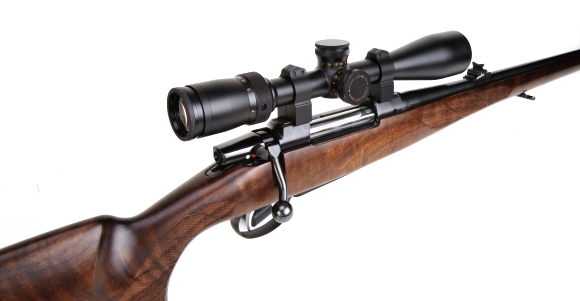
With a 20.5″ barrel and 6.5x55mm ballistics, a Weaver Super Slam 2-10x42mm is an appropriate selection for the CZ 550 FS. Mounted on Warne steel rings made for the CZ’s dovetail and locking tab recess, it was an easy installation. High mounts were required to assure the bolt handle would clear the scope’s large ocular lens when the action was cycled. Good looking rifle, good looking scope. Between the fore and aft locating latitude of the CZ’s dovetail receiver slots, the scope’s tube length and its generous eye relief the combination made for a comfortable and reliable sighting system. A quick laser boresight run-through got the preliminary sighting in out of the way. All of the pieces fell into place for a relatively neutral range scope adjustment.
During handload development, and other live fire activity, the Weaver scope was well behaved and stayed put. Good eye relief was a big plus, elevation and windage adjustments were right on and predictable and the EBX glass etched reticle was intuitive in use, regardless shooting distances. I believe this is the best product Weaver had introduced in some time and well worth the price.
6.5x55mm Swedish Mauser – The little engine that could…
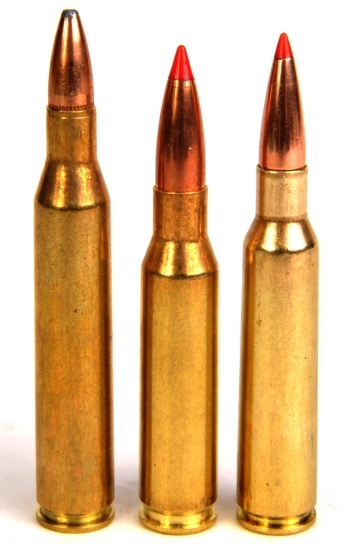
I bet it would surprise a lot of people to learn that the 6.5x55mm Swedish Mauser can just about duplicate the performance of the .264 Winchester Magnum…and I’d be one of them as it won’t even come close. For cartridge size perspective, L-R; 25-06 Remington, the 7mm-08 Remington and the 6.5x55mm Swedish Mauser.
The 6.5 is not a little cartridge. The 260 Remington has 53 grains of capacity, the .308 Winchester 56 grains and the 6.5x55mm 57 grains of capacity. The 6.5 is also not the rocket sled of the .264’s as its capacity is dwarfed by the .264 Winchester Magnum’s 82 grains of capacity. So the 6.5x55mm Mauser sits in a good place, somewhere between, “I bet this would work on elk?” and 400 rounds of barrel life.
The 6.5x55mm shares a trait with the .45-70 Gov’t. No punchline to follow. Both the .45-70 and 6.5x55mm appear in hardcopy handloading manuals, each as more than one separate cartridge listing. The first listing reflects less sturdy original firearms chambered for the respective cartridge, the second listing reflects the cartridge for use in firearms of stronger design and made with better materials.
That’s right, you heard it here. Don’t use high pressure 6.5x55mm loads in an original .45-70 Trapdoor Springfield. That’s a joke, son. Get over yourself. Original 6.5x55mm firearm types, models 94 and 96 military Mauser actions, are kept below the current SAAMI MAP of 46,000 CUP. There is no published SAAMI transducer PSI spec for this cartridge and, for as much as some people would like to believe, there is no cross value calculation to derive one from CUP. Mainstream reloading manuals with listings for modern firearms, such as the subject CZ 550, edge up toward 58,000 – 60,000 PSI, or about the same at the .260 Remington. The boost above the actual pressure spec is not of minor consequence as it is enough to push a 120 grain bullet to 2,800 fps of muzzle velocity, or approximately 200 fps above muzzle velocity attained at spec pressure. These plus loads are slightly warmer than current European CIP commercial ammo which is loaded to approximately 55,000 PSI equivalent.
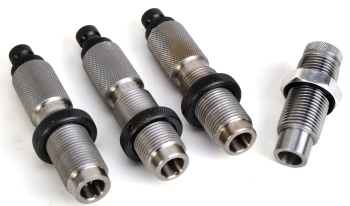
A Redding Deluxe Die Set was selected for the handloading portion of the project. The set contains a full length and a neck sizer in addition to the seating die. I don’t know what happened. I started using a Redding Turret press, was impressed, and before I knew it I’d gone upscale on dies also. Nice equipment. The lonely guy on the far right is a Lee Precision factory crimp die, a good piece of tooling and something I look for where crimping applies to a cartridge.
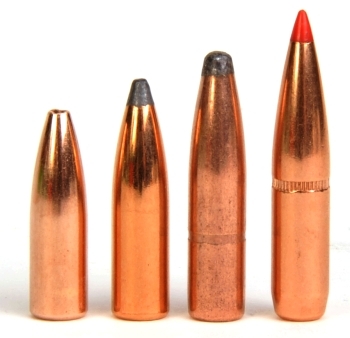
Four bullets were selected that seemed reasonably representative of the cartridge’s range and capability. They are, left to right: 100 grain Sierra Varminter, 120 grain Sierra Pro-Hunter, 139 grain SPBT Prvi, and 140 grain Hornady SST.
There are bullet weights from 85 grains to 160 grains generally available for the 6.5. The 160s made by Hornady and Woodleigh are both soft pointed, thin jacketed and round nosed. Lapua makes a 155 grain and Norma makes a 156 grain of similar profile and construction. Norma, a company that probably best knows heavyweight 6.5 applications, also produces two 156 grain bonded bullets that are closer to a spitzer, one with a protected tip. Still too much weight for my applications.
The .264″ bullet in broader context – Sectional density for the 140 grain bullets is approximately 0.287, which is in line with a 190 grain 0.308″ bullet, about the same as a 160 grain 0.284″ bullet and greater than a 150 grain 0.277″ bullet. While the 160 grain 6.5mm may have an edge over the 140 grain bullet in momentum and theoretical penetration, as a practical matter, any penetration performance edge would be lost to the 160 grain bullet’s more fragile construction.
And then there was a lot of noise….
|
6.5x55mm Swedish Mauser Handloads – 20.5″ Barrel CZ 550 FS |
|||||||||
| Bullet Mfg | Bullet # | Weight Grains |
Length “ |
COL “ |
Powder Type |
Powder Charge |
Actual Velocity |
Muzzle Energy |
3 Shot Group “ |
| Sierra | 1710 | 100 | 0.936 | 2.850 | Varget | 46.0 | 3168 | 2229 | 0.7 |
| H4350 | 50.0 | 3066 | 2088 | 0.9 | |||||
| Sierra | 1720 | 120 | 1.084 | 3.000 | Re19 | 50.5 | 2950 | 2319 | 1.2 |
| H4350 | 48.5 | 2971 | 2353 | 1.0 | |||||
| Prvi | B-084 | 139 | 1.201 | 2.985 | Re19 | 48.0 | 2719 | 2282 | 1.3 |
| H4350 | 45.5 | 2651 | 2170 | 1.1 | |||||
| Hornady | 26302 | 140 | 1.395 | 2.965 | Re19 | 46.0 | 2658 | 2197 | 1.0 |
| H4350 | 44.0 | 2675 | 2225 | 0.8 | |||||
|
Note: CCI 200 Primers were used for all loads. |
|||||||||
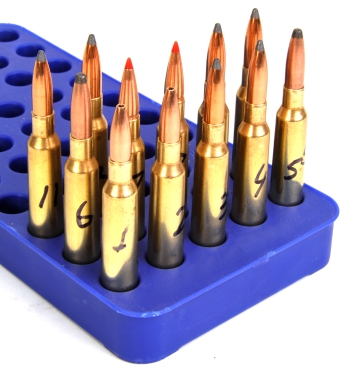
I’ve been handloading for quite some time and I’ve encountered lots of cartridge idiosyncrasies. The 6.5x55mm had a few of its own. There was a substantial accuracy difference amongst ammunition assembled from new, once-fired neck resized and full length resized cases. The group sizes appearing on the table above were shot with once-fired, neck resized brass. New and full length resized produced groups that were 0.200″ – 0.300″ larger with the same loads.
| Brass Type | Neck D | Headspace Δ |
| New | 0.431″ | 0.000″ |
| Once Fired | 0.438″ | -0.001″ |
| F/L Sized | 0.436″ | -0.002″ |
Can’t remember a time when I had a rifle show so little headspace increase. Shoulder diameter increase was a bit, but spec is only 0,435″ so there wasn’t much going on here either.
The most consistently accurate load was the Sierra 120 grain, with a charge cut back to 47.5 grains of H4350. With once fired and neck sized only cases, the load produced 2836 fps of muzzle velocity and shot lots of 0.6 and 0.7″ 3 shot groups.
The combination…

The 6.5x55mm chambered CZ 550 FS shoots like a much lighter caliber gun, but obviously packs considerable punch. Muzzle blast was actually…brisk. I’ll chalk this up to short barrel and decent cartridge case capacity. Recoil, for all intents and purposes is non-existent. I’ll chalk that up to a little extra gun heft and excellent recoil pad.
| Indices | 120 Grain Sierra | ||||||||
| Range – yds. | 0 | 50 | 100 | 150 | 200 | 250 | 300 | 350 | 400 |
| Velocity – ft./sec. | 2971 | 2838 | 2708 | 2582 | 2459 | 2340 | 2224 | 2112 | 2004 |
| Energy – ft.-lbs. | 2352 | 2145 | 1953 | 1775 | 1611 | 1459 | 1318 | 1189 | 1070 |
| Path – in. | -1.5 | 0.6 | 1.6 | 1.5 | 0.0 | -2.9 | -7.4 | -13.7 | -21.9 |
Not bad for a 20.5″ barrel gun. Flat enough shooting for 350 yards and enough retained energy for deer and similar size game. It is a good companion rifle for the 9.3x62mm and a rifle that instill pride of ownership. It is no heavier or lighter than other standard weight rifles and it is not too heavy to carry a ways. I think it’s short length and ballistic performance makes it a more than reasonable gun for Maine and places of similar topography and its accuracy makes for a gun that can be taken hunting with confidence.
Wish list for this model…
For this barrel length, in this moderate bore range I think I’d stay with the 6.5x55mm Mauser round, maybe add the 7×57 Mauser with similar case capacity as another model option that would better support the next increment of bullet weight. I would love to see a full-length very lightweight synthetic stock, or see CZ go to work on the stock and action, thinning until the gun was down in the 6.5 lbs range. But then, this close with a factory rifle, maybe some moderate gunsmithing could get me the rest of the way.
Related Information –
A 9.3x62mm Retro Beauty
Czech-ing Out The 9.3x62mm
Big Optical Performance from the “Right” Scope

Email Notification